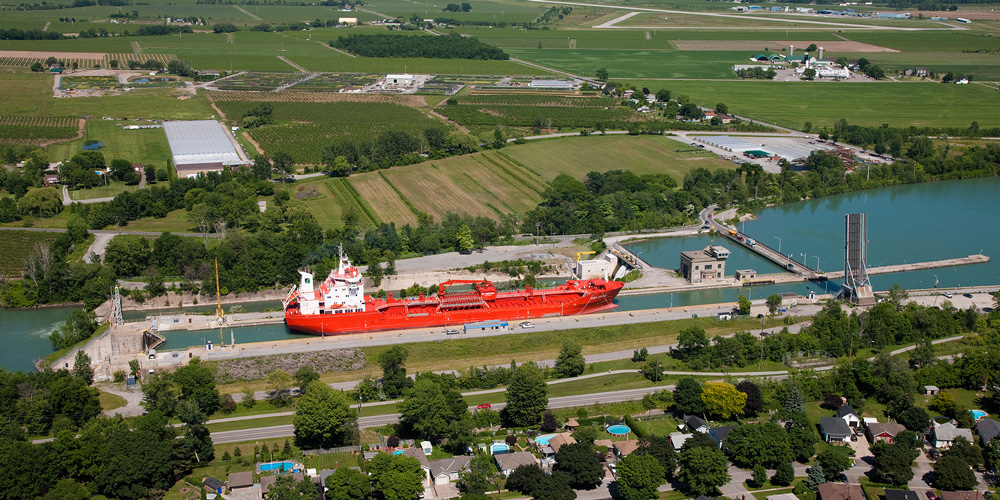Seaway Ties Record for Longest Navigation Season
January 16, 2017
Cornwall, Ontario (January 16, 2017) – After opening the 2016 season on March 21, the St. Lawrence Seaway closed on December 31, enjoying a navigation season of 286 days. This performance ties the record first established in 2008 and matched in 2013 for the longest navigation season.
The St. Lawrence Seaway Management Corporation recorded a total of 35 million tonnes of cargo transiting the Seaway’s locks in 2016. Grain movements posted a strong performance for a third consecutive season, contributing 11 million tonnes of the total and continuing to track well above the five-year average.
The Port of Thunder Bay, the principal point of entry for grain into the Great Lakes St. Lawrence Seaway System, reported a late-season surge in grain activity, as loadings in December trumped all previous December activity since 1995. Grain activity was also strong in the U.S. as the total volume originating from ports such as Duluth / Superior and Toledo increased by 21% during 2016.
“The Seaway System is able to respond to unpredictable surges in cargo movements from a broad number of sectors” noted Terence Bowles, President and CEO of The St. Lawrence Seaway Management Corporation (SLSMC). “We take it all in stride” said Bowles.
U.S. Saint Lawrence Seaway Development Corporation Administrator Betty Sutton said, “The final tonnage statistics for the 2016 Seaway navigation season are a validation of the importance of the Great Lakes St. Lawrence Seaway System to the economy of North America’s ‘Opportunity Belt’. Cargo shipments this past year supported manufacturing, construction, energy, agriculture, and other industries throughout the Great Lakes region. In particular, the movement of containers with high value project cargo is an area where we foresee continued growth in the future. We are pleased to see our marketing efforts generating new opportunities in the global marketplace as businesses realize the value of utilizing our System.”
Serving as a vital trade artery, the Great Lakes St. Lawrence Seaway System enables cargo to move between North America and more than 50 countries across the globe. “Without a doubt, agricultural commodities have become increasingly important, and it’s rewarding to see the pace of new investment by grain companies in ports along our waterway” said the SLSMC’s Terence Bowles. “What we need to keep in mind is that while grain movements may be the key player this year, we have the capacity and the adaptability to service any number of diverse clients and their cargo requirements. In a world economy characterized by volatility and unpredictable swings in trade patterns, the Seaway System provides a resilient transportation network that keeps all types of goods moving”.
Quick Facts:
- For the 2016 navigation season, the last vessel to transit the Seaway’s Montreal / Lake Ontario section was the G3 Marquis which cleared the Iroquois Lock on December 29 at 6:18 PM, heading for Lake Ontario. The last vessel to transit the Seaway’s Welland Canal was the Algolake, which departed Lock 8(Port Colborne) at 8:03 PM on December 30 heading for Lake Erie.
- The Great Lakes St. Lawrence Seaway System is a “marine highway” that extends some 3,700 km from the Atlantic Ocean to the Great Lakes. Approximately 160 million tonnes of cargo travels over the System on an annual basis, supporting over 227,000 jobs and $35 billion in economic activity.
- The binational St. Lawrence Seaway serves as the linchpin within the broader waterway, connecting the lower St. Lawrence River to the Great Lakes. Beginning in Montreal and extending to points west, the Seaway’s 15 locks (13 Canadian and 2 U.S.) enable ships to climb a total of 168 metres from “sea level” up to Lake Erie. For more information on the St. Lawrence Seaway, please consult www.greatlakes-seaway.com.
About The St. Lawrence Seaway Management Corporation:
- The St. Lawrence Seaway Management Corporation was established in 1998 as a not-for-profit corporation by the Government of Canada, Seaway users and other key stakeholders. In accordance with provisions of the Canada Marine Act, the Corporation manages and operates the Canadian assets of the St. Lawrence Seaway, which remain the property of the Government of Canada, under a long-term agreement with Transport Canada.






